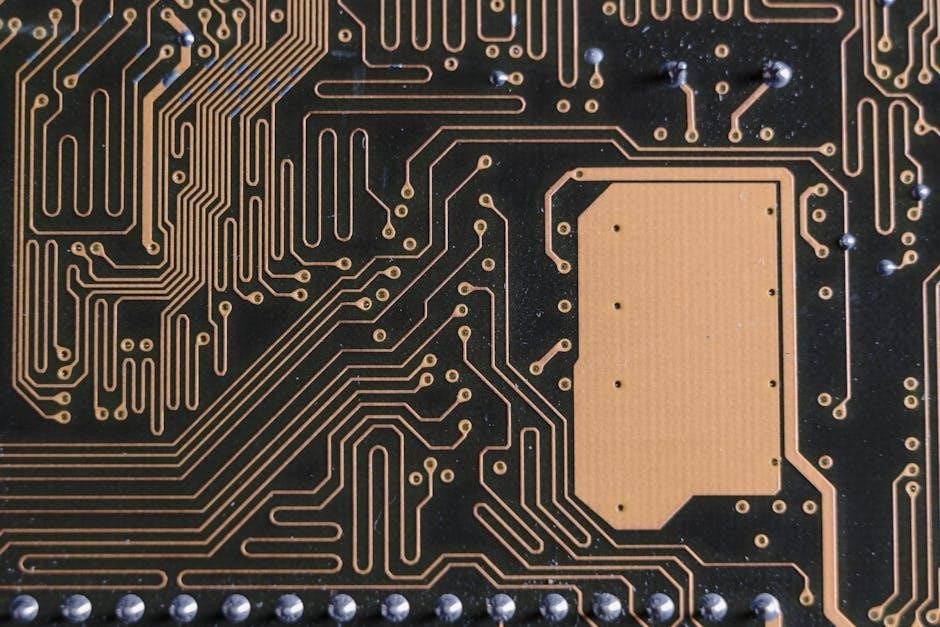muscular system pdf
The muscular system consists of specialized cells called muscle fibers‚ enabling movement‚ support‚ and posture․ It includes over 600 skeletal muscles‚ essential for human mobility and function․
1․1 Overview of the Muscular System
The muscular system comprises three types of muscle tissue: skeletal‚ smooth‚ and cardiac‚ each with distinct functions and structures․ Skeletal muscles‚ attached to bones via tendons‚ enable voluntary movements and locomotion․ Smooth muscles‚ found in internal organs‚ perform involuntary actions like regulating digestion․ Cardiac muscle‚ exclusive to the heart‚ ensures continuous‚ rhythmic contractions․ The system is supported by connective tissue‚ such as fascia and ligaments‚ which provide structure and protection․ With over 600 skeletal muscles‚ the system is integral to movement‚ posture‚ and bodily functions․ Its adaptability and responsiveness are vital for maintaining homeostasis and enabling daily activities․
1․2 Importance of the Muscular System in the Human Body
The muscular system plays a vital role in enabling movement‚ maintaining posture‚ and supporting bodily functions․ It facilitates locomotion‚ allowing individuals to perform daily activities like walking‚ running‚ and climbing․ Muscles also provide structural support‚ ensuring proper alignment of bones and preventing injury․ Additionally‚ they contribute to blood circulation by aiding the return of venous blood to the heart․ Muscular contractions generate heat‚ which helps regulate body temperature․ The system further protects internal organs‚ such as the abdominal muscles shielding the digestive organs․ Overall‚ the muscular system is essential for maintaining mobility‚ stability‚ and overall health‚ making it a cornerstone of human physiology and function․

Types of Muscle Tissue
The human body contains three distinct types of muscle tissue: skeletal‚ smooth‚ and cardiac․ Each type varies in structure‚ function‚ and control mechanisms‚ enabling diverse physiological roles․
2․1 Skeletal Muscle
Skeletal muscle is a voluntary‚ striated muscle tissue attached to bones via tendons‚ enabling movement and locomotion․ It is the most abundant muscle type‚ forming the muscular system․ Each skeletal muscle is an organ composed of muscle fibers‚ connective tissue‚ blood vessels‚ and nerves․ The fibers are grouped into fascicles‚ surrounded by perimysium‚ and the entire muscle is enclosed in epimysium․ Skeletal muscles are responsible for body movements‚ maintaining posture‚ and regulating body temperature․ They are controlled by the somatic nervous system‚ allowing precise and intentional actions․ With over 600 identified skeletal muscles‚ they play a crucial role in human mobility and physical function‚ making them essential for daily activities and overall bodily mechanics․
2․2 Smooth Muscle
Smooth muscle is a non-striated‚ involuntary muscle tissue located in the walls of internal organs and structures‚ such as the digestive tract‚ blood vessels‚ and airways․ It is responsible for slow‚ sustained contractions that facilitate functions like peristalsis‚ blood pressure regulation‚ and respiratory airflow․ Unlike skeletal muscle‚ smooth muscle operates involuntarily‚ controlled primarily by the autonomic nervous system and hormones․ Its structure lacks the orderly arrangement of sarcomeres seen in striated muscles‚ allowing for gradual‚ tonic contractions․ Smooth muscle plays a critical role in maintaining internal bodily functions without conscious control‚ ensuring processes like digestion and circulation occur smoothly and efficiently․
2․3 Cardiac Muscle
Cardiac muscle is a specialized‚ striated‚ involuntary muscle tissue found exclusively in the walls of the heart․ It is designed for endurance and consistent‚ rhythmic contractions to pump blood throughout the body․ Unlike skeletal muscle‚ cardiac muscle cells are branching and interconnected through intercalated discs‚ which contain gap junctions for rapid electrical synchronization․ This unique feature allows the heart to function as a single‚ coordinated unit․ Cardiac muscle is also self-excitable‚ generating its own action potentials without external stimulation‚ though it is regulated by the autonomic nervous system․ Its structure and properties enable it to sustain lifelong activity‚ ensuring continuous blood circulation․ Cardiac muscle is essential for maintaining cardiovascular health and overall bodily function․

Functions of the Muscular System
The muscular system facilitates movement‚ maintains posture‚ supports the body‚ aids in blood circulation‚ and generates heat․ These functions are essential for overall bodily function and survival․
3․1 Movement and Locomotion
The muscular system plays a vital role in enabling movement and locomotion by contracting skeletal muscles attached to bones via tendons․ This contraction pulls bones‚ allowing joints to move․ Muscles work in pairs‚ with one muscle moving a bone in one direction and another reversing the action․ The arrangement of muscle fibers into fascicles enhances strength and efficiency․ The organization of skeletal muscles varies‚ with some muscles arranged in parallel or pennate formations to optimize movement․ This system enables activities like walking‚ running‚ and even fine movements like writing․ The nervous system controls these contractions‚ ensuring precise and coordinated movements․ Without the muscular system‚ voluntary movement and locomotion would be impossible‚ making it essential for daily activities and maintaining an active lifestyle․
3․2 Support and Posture
The muscular system provides essential support and maintains posture by continuously working to balance the body․ Skeletal muscles‚ particularly those in the back and abdominal regions‚ contract to stabilize the spine and prevent slouching․ Postural muscles work involuntarily‚ often without conscious effort‚ to ensure the body remains upright․ This support is crucial for protecting internal organs and maintaining proper alignment‚ which prevents strain and injury․ Additionally‚ muscles in the neck and shoulders contribute to holding the head in position‚ allowing for clear vision and balance․ The ability to sit or stand for extended periods relies heavily on the endurance of postural muscles․ Without this support‚ the body would struggle to maintain its structure‚ leading to discomfort and potential long-term damage․ Thus‚ the muscular system is indispensable in preserving both posture and overall bodily stability․
3․3 Blood Circulation
The muscular system plays a vital role in aiding blood circulation‚ particularly through muscle contractions․ Skeletal muscles‚ especially those in the legs‚ contract and relax rhythmically‚ which helps push blood upward through veins toward the heart․ This action is crucial for overcoming gravity‚ especially during upright posture․ Smooth muscles in blood vessel walls also contribute by adjusting vessel diameter to regulate blood flow and pressure․ Cardiac muscle‚ found in the heart‚ is responsible for pumping blood throughout the body․ Together‚ these muscle types ensure efficient blood circulation‚ delivering oxygen and nutrients to tissues while removing waste products․ Regular muscle activity enhances this process‚ improving overall cardiovascular health and maintaining proper bodily functions․ This interplay between muscle contraction and blood flow is essential for sustaining life and overall well-being․
3․4 Heat Production
Muscle contractions generate heat‚ which is essential for maintaining body temperature․ During physical activity‚ skeletal muscles produce heat as a byproduct of cellular respiration․ Even at rest‚ muscles release heat through basal metabolic processes․ Shivering‚ an involuntary contraction of skeletal muscles‚ is a key mechanism for generating heat in cold environments․ This heat production is vital for thermoregulation‚ ensuring proper bodily functions․ The muscular system’s role in heat production highlights its importance in overall physiology‚ contributing to energy expenditure and maintaining homeostasis․ This function is integral to survival‚ especially in varying environmental conditions‚ showcasing the system’s adaptability and essential role in human health․ Muscular activity‚ whether voluntary or involuntary‚ plays a central role in regulating body heat‚ underscoring its significance in daily life․

Microscopic Anatomy of Skeletal Muscle
Skeletal muscles consist of elongated muscle fibers wrapped in connective tissue‚ containing myofibrils with sarcomeres‚ the contractile units‚ and sarcoplasm rich in myoglobin and glycogen․
4․1 Structure of a Skeletal Muscle Fiber
A skeletal muscle fiber is an elongated cell containing multiple nuclei and specialized organelles․ It is wrapped in a plasma membrane and surrounded by connective tissue called endomysium․ Inside‚ myofibrils‚ composed of repeating units called sarcomeres‚ are the functional units of contraction․ Sarcomeres contain actin and myosin filaments that slide past each other during contraction․ The sarcoplasm‚ the cytoplasm of the muscle fiber‚ contains glycogen‚ myoglobin‚ and mitochondria for energy production․ Transverse tubules (T-tubules) and the sarcoplasmic reticulum regulate calcium ion flow‚ essential for contraction․ This highly organized structure enables skeletal muscles to perform voluntary movements efficiently․
4․2 Role of Connective Tissue in Muscles
Connective tissue plays a vital role in muscle structure and function by providing support and protection․ It wraps around individual muscle fibers‚ forming endomysium‚ and bundles them into fascicles with perimysium․ A thick layer of connective tissue‚ the epimysium‚ encases the entire muscle․ This tissue also forms tendons and ligaments‚ attaching muscles to bones and other structures‚ enabling movement․ Connective tissue aids in force transmission during contraction and houses blood vessels and nerves‚ ensuring proper nourishment and innervation․ It also reduces friction between moving parts‚ preventing injury․ Thus‚ connective tissue is essential for organizing muscle fibers‚ facilitating muscle function‚ and maintaining overall muscle integrity and efficiency․ Its role is crucial for movement‚ stability‚ and the structural organization of the muscular system․
4․3 Neuromuscular Junction
The neuromuscular junction (NMJ) is a specialized synapse between a motor neuron and a skeletal muscle fiber‚ enabling precise communication and muscle contraction․ It consists of the axon terminal‚ synaptic cleft‚ and motor endplate․ When a nerve impulse reaches the axon terminal‚ neurotransmitters like acetylcholine are released into the synaptic cleft․ These molecules bind to receptors on the motor endplate‚ triggering depolarization and initiating muscle contraction․ The NMJ is essential for voluntary movements‚ as it translates neural signals into physical actions․ Its proper function is vital for coordination and locomotion‚ while disorders affecting the NMJ‚ such as myasthenia gravis‚ can severely impair muscle control and movement․ The NMJ exemplifies the intricate integration of the nervous and muscular systems in facilitating bodily functions․

Muscular Disorders and Diseases
Muscular disorders‚ such as muscular dystrophy‚ myasthenia gravis‚ and fibromyalgia‚ impair muscle function and movement․ These conditions often result from genetic‚ autoimmune‚ or infectious factors‚ significantly affecting mobility and quality of life․
5․1 Common Muscular Disorders
Common muscular disorders include muscular dystrophy‚ myasthenia gravis‚ and fibromyalgia․ Muscular dystrophy is a genetic condition causing progressive muscle weakness and degeneration․ Myasthenia gravis is an autoimmune disease affecting nerve-muscle communication‚ leading to muscle fatigue and weakness․ Fibromyalgia is characterized by widespread muscle pain‚ stiffness‚ and fatigue․ Other disorders include tendinitis‚ bursitis‚ and muscle strains‚ often due to overuse or injury․ These conditions vary in severity and impact‚ affecting mobility‚ quality of life‚ and overall health․ Early diagnosis and treatment are crucial for managing symptoms and improving outcomes․ Understanding these disorders is essential for promoting awareness and effective care․
5․2 Impact of Muscular Diseases on Quality of Life
Muscular diseases significantly impair daily activities‚ mobility‚ and independence․ Chronic pain‚ weakness‚ and fatigue disrupt sleep and overall well-being․ Conditions like muscular dystrophy and fibromyalgia often lead to emotional distress‚ including anxiety and depression․ Social interactions may suffer due to limited mobility and reduced participation in activities․ Economic burdens arise from medical expenses and potential loss of employment․ However‚ rehabilitation‚ assistive devices‚ and therapies can improve functionality and quality of life․ Emotional support and understanding from caregivers are crucial for patients․ Early intervention and comprehensive care can mitigate the impact of muscular diseases‚ enabling individuals to maintain dignity and independence despite their challenges․
The muscular system plays a vital role in enabling movement‚ maintaining posture‚ and supporting bodily functions․ Comprising skeletal‚ smooth‚ and cardiac muscles‚ it is essential for locomotion‚ blood circulation‚ and heat production․ Understanding its structure‚ function‚ and disorders is crucial for appreciating human physiology․ Muscular diseases‚ such as dystrophy and myopathies‚ significantly impact quality of life‚ emphasizing the importance of early diagnosis and care․ Advances in research and therapy continue to improve outcomes for those affected․ In conclusion‚ the muscular system is a complex and indispensable component of the human body‚ deserving of attention and care to maintain overall health and well-being․ Its study remains fundamental to medicine and our understanding of human movement and function․
